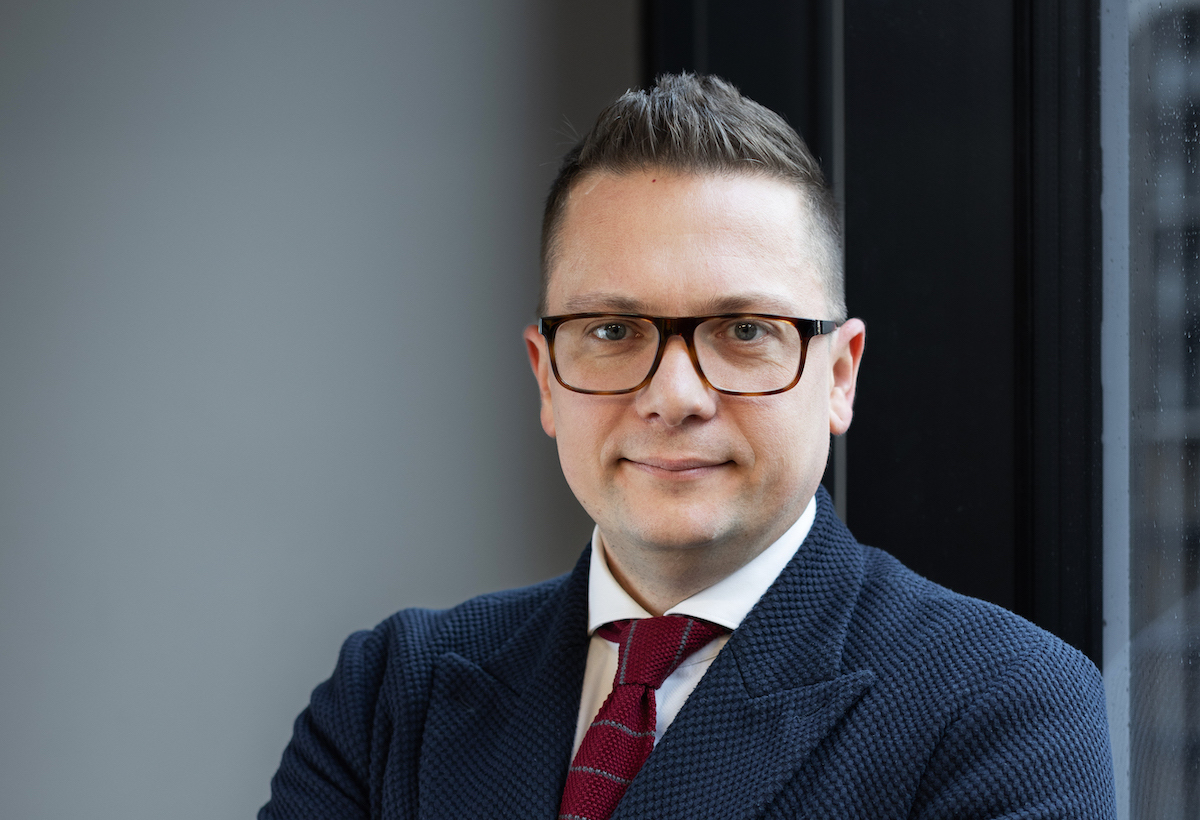MITS Capital Invests Millions in Ukrainian Defence Tech: How It Works
The meeting with Denys Gurak, co-founder of MITS Capital, had been arranged in advance. His schedule is tight. Even with an hour at our disposal, there was far too much to cover: we wanted to talk not only about Defence Tech startups in Ukraine, but also the global context. Denys has extensive expertise in both. After 2014, he was involved in reforms at Ukroboronprom and has plenty to say about that period and about Ukraine’s preparation for the full-scale invasion. Another topic that surfaced often was the challenges facing the defense industry today.
At the same time, Gurak doesn’t see challenges as purely negative. He points out that Ukraine is gaining experience that no partner nation and perhaps no other country currently has. The full-scale war has forced the US and Europe to rethink military doctrines. For Europe in particular, Ukraine’s front line has become a catalyst for rearmament after decades of underinvestment. If Kyiv can seize this moment, it has the potential to become a major defence tech hub for the democratic world.

Together with partners Perry Boyle and Anton Melnyk, Denys decided to channel their experience into building Ukrainian technology companies in the defense sector. That’s how MITS Capital was born, a company that works with startups across several stages of development. In this interview with Scroll.media, Denys explains how it all works.
How does the investment firm operate? We’ve heard about your acceleration program, and now there’s news of your first significant, multimillion-dollar investments.
MITS Capital is an investment group working across different Technology Readiness Levels (TRL).
- We start with MITS Lab, where we identify future frontline problems and find engineering solutions to address them.
- Next comes the accelerator, designed to help teams find Product–Market Fit and build a Go-to-Market strategy. Many Ukrainian Defence Tech startups are products, not companies — there might be a drone or robot that can perform a task, but there’s no structured business behind it. We teach teams how to build a proper company to secure orders and attract investment.
- The last stage is the fund, which involves substantial investments and additional support, including M&A preparation.
- We also have an Investment Banking division for mature companies that are not seeking acceleration or venture investment. We advise them, support M&A transactions, attract strategic investors.
With our latest significant investments, you can now clearly see all stages of our work in action.
How big is the team, and who’s on it?
There are almost 20 people. Some are cross-functional specialists, but most focus on delivering the four core processes I described.
What’s the size of the fund? Who are your main LPs?
We don’t disclose the fund size. Our ambition is to invest hundreds of millions of dollars in Ukraine. We haven’t raised that much yet, but we’re working toward it. We’re ready to invest heavily because the opportunities we see are at least 10× the current volume of investments. We also don’t name our LPs. Broadly, they’re from Europe and the US.
Are there really enough big-scale Ukrainian startups to absorb that kind of capital?
Our company’s thesis is that money is needed for scaling. This isn’t traditional venture capital, where you gradually give money for rounds A and B and then go for an IPO.
We’re in the middle of a big war. Say a startup has invented an exceptional motor for drones — they need to scale now, build production facilities, and supply both the front line and government contracts. For investors, that means dividends or an exit via M&A.
That’s a typical situation for the defence tech industry but unusual for Ukraine, where this market barely existed three years ago. Winning the war requires unprecedented production volumes, so yes, there’s room for significant investment.
It’s also crucial for institutional capital to enter Ukraine. Denmark’s $5 million allocation to D3 is a good example. We need more of those; such investors understand the scale of what’s being built here.
So your investment ceiling is based on need, not a fixed ticket size?
Exactly. We base funding on strategy. That’s why we start with acceleration: six months working with startups to determine how much they actually require. During the program, we help them build financial models and business plans — everything needed to define demand.
It takes some effort because most founders are engineers or IT specialists, not seasoned entrepreneurs. We teach them structured thinking while navigating one of the most complex, regulated markets. This is essential if you want to build a real company, not just a small workshop.
Do you only invest in startups that go through your accelerator?
Essentially, yes — it’s our sandbox.
The accelerator is a joint program with American University Kyiv. Who developed it?
We did, together. AUK handles the business side, drawing from the University of Arizona’s program.
We take responsibility for the military side and involve members of our supervisory board with global defence market experience. They help us make investment decisions and build trust in the Ukrainian defence tech industry.
What are the trust issues?
Ukraine has to deal with the global narrative about corruption — the fear that «everything will be stolen.» At the same time, there’s the reality of our Armed Forces’ achievements, innovative engineering, and strong technical education. Involving the international community proves that Ukrainian businesses can operate by the book. Our experience shows it works.
How many projects have you invested in so far?
Eleven.
But only two — Teletactica and Tencore — have been announced publicly. Why?
Security. Too much publicity makes you a target for Russian missiles. Some founders simply don’t want that risk. In wartime, it’s better not to spotlight certain developments.

What are your priority investment areas?
Beyond complex products, we value components — motors, cameras, AI — anything that helps Ukrainian manufacturers cut dependence on China. That way, they can also sell to other countries. We’re also interested in platforms and integrators.
Our core thesis is to reduce reliance on the Chinese supply chain. We believe Ukraine’s expertise can help Europe and, ideally, the US escape that dependence. Both are deeply tied to Chinese suppliers and are hesitant to break away.
So you’re not focused on dual-use tech?
Any quality military technology can be adapted for dual use.
Even a missile?
Not the whole missile, obviously, but its engine, circuit boards, and other components could be sold on civilian markets. That’s actually easier: exporting weapons is currently impossible, but components can be exported and, sometimes, with higher margins.
What’s the biggest challenge for the defence tech industry in Ukraine?
Structure and scaling. Russia mass-produces just three drone models and still terrorizes Ukrainian cities with them. They put Shaheds on an assembly line. They rolled out fiber-optic production at speed. Ukraine lacks that consistency. We have 10 different companies making DeepStrike drones, each under its own agency. I believe this fragmentation works against us. The Ukrainian defense industry needs a smarter, more coordinated approach.
***
Throughout our conversation, Denys kept returning to one key point: Ukrainian defence tech startups don’t need sky-high paper valuations — they need large sums to scale production now.
«I’ll never tire of saying it: of course, we have to build businesses. But our number-one goal is to win the war. We can compete for LPs, for startups, and for higher valuations, but if we lose the war, there will be no Ukrainian defence tech industry. What difference does it make how much we earn if we lose? If we win, that alone is a huge victory — and everyone will earn so much it’s impossible to calculate today. For me, Ukrainian Defence Tech isn’t about a slick pitch deck; it’s about bringing victory closer and having a real impact on the battlefield.»
MITS Capital Invests Millions in Ukrainian Defence Tech: How It Works
The meeting with Denys Gurak, co-founder of MITS Capital, had been arranged in advance. His schedule is tight. Even with an hour at our disposal, there was far too much to cover: we wanted to talk not only about Defence Tech startups in Ukraine, but also the global context. Denys has extensive expertise in both. After 2014, he was involved in reforms at Ukroboronprom and has plenty to say about that period and about Ukraine’s preparation for the full-scale invasion. Another topic that surfaced often was the challenges facing the defense industry today.
At the same time, Gurak doesn’t see challenges as purely negative. He points out that Ukraine is gaining experience that no partner nation and perhaps no other country currently has. The full-scale war has forced the US and Europe to rethink military doctrines. For Europe in particular, Ukraine’s front line has become a catalyst for rearmament after decades of underinvestment. If Kyiv can seize this moment, it has the potential to become a major defence tech hub for the democratic world.

Together with partners Perry Boyle and Anton Melnyk, Denys decided to channel their experience into building Ukrainian technology companies in the defense sector. That’s how MITS Capital was born, a company that works with startups across several stages of development. In this interview with Scroll.media, Denys explains how it all works.
How does the investment firm operate? We’ve heard about your acceleration program, and now there’s news of your first significant, multimillion-dollar investments.
MITS Capital is an investment group working across different Technology Readiness Levels (TRL).
- We start with MITS Lab, where we identify future frontline problems and find engineering solutions to address them.
- Next comes the accelerator, designed to help teams find Product–Market Fit and build a Go-to-Market strategy. Many Ukrainian Defence Tech startups are products, not companies — there might be a drone or robot that can perform a task, but there’s no structured business behind it. We teach teams how to build a proper company to secure orders and attract investment.
- The last stage is the fund, which involves substantial investments and additional support, including M&A preparation.
- We also have an Investment Banking division for mature companies that are not seeking acceleration or venture investment. We advise them, support M&A transactions, attract strategic investors.
With our latest significant investments, you can now clearly see all stages of our work in action.
How big is the team, and who’s on it?
There are almost 20 people. Some are cross-functional specialists, but most focus on delivering the four core processes I described.
What’s the size of the fund? Who are your main LPs?
We don’t disclose the fund size. Our ambition is to invest hundreds of millions of dollars in Ukraine. We haven’t raised that much yet, but we’re working toward it. We’re ready to invest heavily because the opportunities we see are at least 10× the current volume of investments. We also don’t name our LPs. Broadly, they’re from Europe and the US.
Are there really enough big-scale Ukrainian startups to absorb that kind of capital?
Our company’s thesis is that money is needed for scaling. This isn’t traditional venture capital, where you gradually give money for rounds A and B and then go for an IPO.
We’re in the middle of a big war. Say a startup has invented an exceptional motor for drones — they need to scale now, build production facilities, and supply both the front line and government contracts. For investors, that means dividends or an exit via M&A.
That’s a typical situation for the defence tech industry but unusual for Ukraine, where this market barely existed three years ago. Winning the war requires unprecedented production volumes, so yes, there’s room for significant investment.
It’s also crucial for institutional capital to enter Ukraine. Denmark’s $5 million allocation to D3 is a good example. We need more of those; such investors understand the scale of what’s being built here.
So your investment ceiling is based on need, not a fixed ticket size?
Exactly. We base funding on strategy. That’s why we start with acceleration: six months working with startups to determine how much they actually require. During the program, we help them build financial models and business plans — everything needed to define demand.
It takes some effort because most founders are engineers or IT specialists, not seasoned entrepreneurs. We teach them structured thinking while navigating one of the most complex, regulated markets. This is essential if you want to build a real company, not just a small workshop.
Do you only invest in startups that go through your accelerator?
Essentially, yes — it’s our sandbox.
The accelerator is a joint program with American University Kyiv. Who developed it?
We did, together. AUK handles the business side, drawing from the University of Arizona’s program.
We take responsibility for the military side and involve members of our supervisory board with global defence market experience. They help us make investment decisions and build trust in the Ukrainian defence tech industry.
What are the trust issues?
Ukraine has to deal with the global narrative about corruption — the fear that «everything will be stolen.» At the same time, there’s the reality of our Armed Forces’ achievements, innovative engineering, and strong technical education. Involving the international community proves that Ukrainian businesses can operate by the book. Our experience shows it works.
How many projects have you invested in so far?
Eleven.
But only two — Teletactica and Tencore — have been announced publicly. Why?
Security. Too much publicity makes you a target for Russian missiles. Some founders simply don’t want that risk. In wartime, it’s better not to spotlight certain developments.

What are your priority investment areas?
Beyond complex products, we value components — motors, cameras, AI — anything that helps Ukrainian manufacturers cut dependence on China. That way, they can also sell to other countries. We’re also interested in platforms and integrators.
Our core thesis is to reduce reliance on the Chinese supply chain. We believe Ukraine’s expertise can help Europe and, ideally, the US escape that dependence. Both are deeply tied to Chinese suppliers and are hesitant to break away.
So you’re not focused on dual-use tech?
Any quality military technology can be adapted for dual use.
Even a missile?
Not the whole missile, obviously, but its engine, circuit boards, and other components could be sold on civilian markets. That’s actually easier: exporting weapons is currently impossible, but components can be exported and, sometimes, with higher margins.
What’s the biggest challenge for the defence tech industry in Ukraine?
Structure and scaling. Russia mass-produces just three drone models and still terrorizes Ukrainian cities with them. They put Shaheds on an assembly line. They rolled out fiber-optic production at speed. Ukraine lacks that consistency. We have 10 different companies making DeepStrike drones, each under its own agency. I believe this fragmentation works against us. The Ukrainian defense industry needs a smarter, more coordinated approach.
***
Throughout our conversation, Denys kept returning to one key point: Ukrainian defence tech startups don’t need sky-high paper valuations — they need large sums to scale production now.
«I’ll never tire of saying it: of course, we have to build businesses. But our number-one goal is to win the war. We can compete for LPs, for startups, and for higher valuations, but if we lose the war, there will be no Ukrainian defence tech industry. What difference does it make how much we earn if we lose? If we win, that alone is a huge victory — and everyone will earn so much it’s impossible to calculate today. For me, Ukrainian Defence Tech isn’t about a slick pitch deck; it’s about bringing victory closer and having a real impact on the battlefield.»




